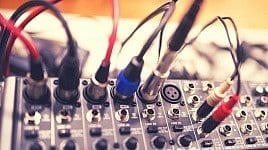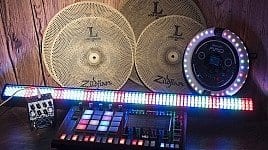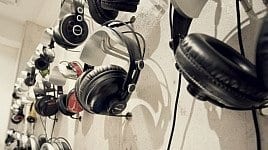
The use of wireless DMX is suitable for all types of events. It is the ideal solution for events and configurations of small and medium sizes. With the corresponding professional equipment, it is also suitable for large events where traditional wiring simply reaches its practical limits. Both approaches have their own advantages. Wireless data transmission is obviously practical, however, the risk of disruptions and failures is just as important. So what are the advantages and disadvantages and how does one react when problems arise? Here are some practical considerations:
Wireless offers clear advantages. When cables aren’t needed, they also don’t need to be hooked up or transported. This saves time and space. Even though the components required for wired transmission operations can fit into one or two flightcases (depending on the size of the event) they can quickly add up and become heavy. Wireless can also prevent the loss (or theft) of cables at gigs, a very common occurrence in show business. The absence of cables also reduces accidents, namely tripping over them on- or offstage.
The transmission of WIFI or wireless data is prone to interference and when this happens there is nothing one can do. It’s no news that the signal strength of available frequencies fluctuates but state-of-the-art wireless transceivers, with “Gaussian Frequency Shift Keying” (GFSK) and/or “Automatic Frequency Hopping Spread Spectrum” (AFHSS) are very promising. Fully automatic, these devices look for the most stable and strongest transmission frequency or “hop” between several good ones.
If there is a disturbance in the transfer of live data, a short moment of “dead air” must be filled, that is, until the system has automatically reconnected or restarted. So how do we deal with these brief yet critical moments?
Good preparation is ALWAYS the beginning of a good solution. One idea would be to consider having many lights, in particular intelligent and movable mobile heads, which are capable of continuing smooth operation / motion if a DMX interruption should occur. The easiest solution is to assign the appropriate factory or preconfigured programs to the lights – in backup mode. An alternative method is to activate the sound to light mode for such an emergency, with the sensitivity of the microphone set to the maximum.
The range proves to be a crucial feature when purchasing a wireless device. While some modem transmitters and receivers promise reliable transmission results over a distance of about 20 meters, there are more professional variants that promise transmissions over distances of 700 meters or more. One can not, and should not, rely exclusively on the transceiver’s range if the goal is the greatest possible security. Countless sources of interference can compromise the end result.
The number one enemy of wireless DMX: Latency
At this point latency comes into play. A little reminder for novices: latency is the delay or “late-ness”, that is, the transfer time between the light control command and its implementation at the receiver. Syncing light and sound is critical and latency will throw your timing off. If the reception of the information packet is delayed it could confuse the lights and cause them to start flashing strangely.
To begin correcting this issue we could consider “lightening” these packets of information. In order to reduce the amount of items transmitted the number of channels could be reduced from 512 to 256 (or even down to 128). You might have less possibilities and controls on your devices but the quality of the signal will surely improve.
It is also logical in this context to select the lowest number of DMX channels on the spotlights themselves. Here too, the less the better, and that is for the safety of the system. There are fewer functions for spots, moving heads and so on. Especially since all device attributes can only be selected in channel mode. Always keep in mind that using a high number of DMX channels in the broadcast could be at the expense of the result.
What do I need for a wireless DMX system and how much does it cost?
The basic equipment is simple: in principle there must be a transmitter and at least one receiver for wireless transmission. Devices that can perform both of these functions are called transceivers. You can find them for just over 100 euros (for both components) and obtain reasonable results. The products in this range, such as Eurolite‘s proven QuickDMX wireless receivers / transmitters, are ideal for anyone looking for a quick, compact solution. For interference-free operation in addition to other wireless devices in the 2.4 GHz band, W-LAN and Bluetooth, so-called GFSK modulation can be used. It allows frequency shifting, which makes the system less sensitive to interference and automatically finds the best transmission frequency available. These reliable features promise a transmission of over several hundred meters as long as visual contact is maintained.
Stairville offers WLS-DMX transceivers, with antenna and power cables which require a budget of about 160 euros per device. ADJ does also, with the EXR Battery for about 120 euros, but without the power cable. This DMX transceiver is battery powered and compatible with all the manufacturer’s WiFly products. Comprehensive DMX interfaces such as the Ape Labs WAPE wireless DMX transceiver cost about 300 euros. The advantages are in the program and the internal equipment of the product. For example, Lightcans DMX channels can be directly assigned to the interface. This is especially advantageous if this function is not available directly on the lights. The model is, unfortunately, only Apple compatible.

Ape Labs WAPE Wireless DMX Transceiver
Swedish brand Wireless Solution offers highly professional technology and many devices. The WhiteBox series is suitable for outdoor use, the ProBox series offers a transmission for several DMX512 universes with built-in repeater. Models such as the BlackBox F1 G4 MK2 and other members of this series are available from 700 euros and more. The transmitter is designed for indoor applications only and supports DMX and RDM signals as well as input protocols such as Art Net, SACN or ETC Net as well as any output protocol such as Ehternet or RS- 485. And, for some time now, there is the G5 update … As is often the case: you get what you pay for.

Wireless Solution BlackBox F1 G4 MK2 Transceiver
If wireless wasn’t so convenient…
The extra costs of wireless are eventually covered in the long run because of how much time you save. But whether wireless or wired DMX lighting is better is debatable. Wireless DMX is very useful and opens up more doors to creativity. Even if the entire configuration is wireless it is customary to leave fixed lights wired in case of a problem. Accessories such as a repeater and/or splitter booster for large indoor spaces will be necessary to ensure the best transmission to all the nooks and crannies. Don’t forget to point the antennas upward, above the crowd. The crowd will absorb frequencies if they are pointing towards the ground.
Learn about the basics of DMX here (includes video tutorial)!
Learn about indispensable lighting gear for your next spectacle!
Come visit our Lighting Department in Treppendorf, we’d love to have you!
Visit the Lighting & Stage page of our online store for all your needs.
One comment
Leave a Reply
You are currently viewing a placeholder content from Facebook. To access the actual content, click the button below. Please note that doing so will share data with third-party providers.
More InformationYou are currently viewing a placeholder content from Instagram. To access the actual content, click the button below. Please note that doing so will share data with third-party providers.
More InformationYou are currently viewing a placeholder content from X. To access the actual content, click the button below. Please note that doing so will share data with third-party providers.
More Information





Davie Hopewell Kweteza says:
Hello.
I am sure you have great and best Lighting sestim, I would love to have a question of DMX cable less device and simple digital DMX Control that can pic over 45 pieces of LED’e and Moving heads.